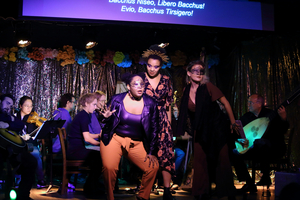Review: THE DEATH OF ORPHEUS at El Cid


On January 17, 2020, Los Angeles Opera presented Stefano Landi's 1619 opera, The Death of Orpheus, (La Morte d'Orfeo) at El Cid, a performance space usually known for dinner theater. Landi may have written his own libretto. In any case, the story of the five-act opera was inspired by Angelo Poliziano's 1484 pastoral tragicomedy La Favola d'Orfeo.
Claudio Monteverdi's 1607 Orfeo ends when the hero fails to bring his wife Eurydice back from the underworld. Landi begins with Orpheus alone and grieving. His hero then renounces wine and the love of women. Those actions offend the god Bacchus whose female and followers, the Maenads, decide to kill Orpheus. The enraged women tear him apart. The gods want the dead Orpheus to stay with them on Olympus but Orpheus prefers to spend eternity with Eurydice in Hades. Only after the god Mercury shows Orpheus that Eurydice no longer remembers him and their marriage because she has drunk the waters of Lethe, does he agree to join the gods on Olympus.
The theater at El Cid holds some 76 patrons with most of them seated at long tables for 12. The stage is tiny and it was filled by the members of the orchestra: two violinists, a harpsichordist, two recorder players who doubled on cornettos, a viola da gamba player who doubled on the lirone, and a Baroque harpist. Conductor Stephen Stubbs, who has recorded this work, played an enormously long-necked chitarrone. Their playing was an excellent example of historically informed musicality.
Singers performed in the spaces between the tables, between the musicians on stage, in front of the stage, and on a balcony above and behind the patrons. From the standpoint of an audience member, soloists could be found in front, behind, beside or even above one's seat. It truly was an immersive experience.
Director Sara E. Widzer portrayed Landi's tragic themes, but lightened them with occasional comic moments that kept the piece from becoming heavy. She told the extended story in an unconventional but most effective manner. Late in the opera, Orpheus has a birthday so each patron was served a drink with which to toast the hero, thus cementing the idea that everyone in hall was part of the show.
Designer Leon Wiebers worked within the confines of the hall's Spanish decor and costumed the singers in either black or bright colors, with shiny metallic decorations when appropriate. He even had some singers wear light weight masks that did not impede their singing. Twelve singers played 19 parts and the specifics of costuming told which part each singer was playing at a given time.
Most of the singers were members of Los Angeles Opera's Domingo-Colburn-Stein Young Artist Program. The exceptions were countertenor Jacob Ingbar, a graduate student at Rice University, and bass-baritone Christopher Carbin who will be debuting this spring as Don Alfonso in Pacific Opera Project's presentation of Mozart's Cosi fan Tutte. Ingbar sang with sweetness and great beauty of tone while Carbin commanded attention with the his strong, resonant sound.
Soprano program members Sylvia D'Eramo, and Erica Petrocelli, along with mezzo-soprano Taylor Raven, sang delightful harmony as the Three Breezes while also performing charming solos. Tenor Anthony Ciaramitaro was a fascinating, guitar-playing Orpheus, and baritone Michael J. Hawk commanded the hall with well-focused tones as Hebros, Charon, and Fury.
Tenor Robert Stahley was an imperious Apollo and an appealing Fileno. Sopranos Alaysha Fox and Sarah Vautour were fierce Maenads, while mezzo Gabriela Flores was a smooth voiced, sympathetic mother. All of the singers in this show had substantial operatic voices that will most likely be heard In opera houses in the United States and Europe. Tonight's show was an excellent performance both vocally and histrionically.
The Death of Orpheus will be repeated at El Cid on January 18th at 7:30 pm following dinner at 6:30 and on the 19th at 7:00 pm after dinner at 6:00. El Cid is located at 4212 Sunset Blvd, Los Angeles CA 90029.
Photos by Craig T. Matthew for LA Opera.
Add Your Comment
To post a comment, you must register and login.Videos
.png)